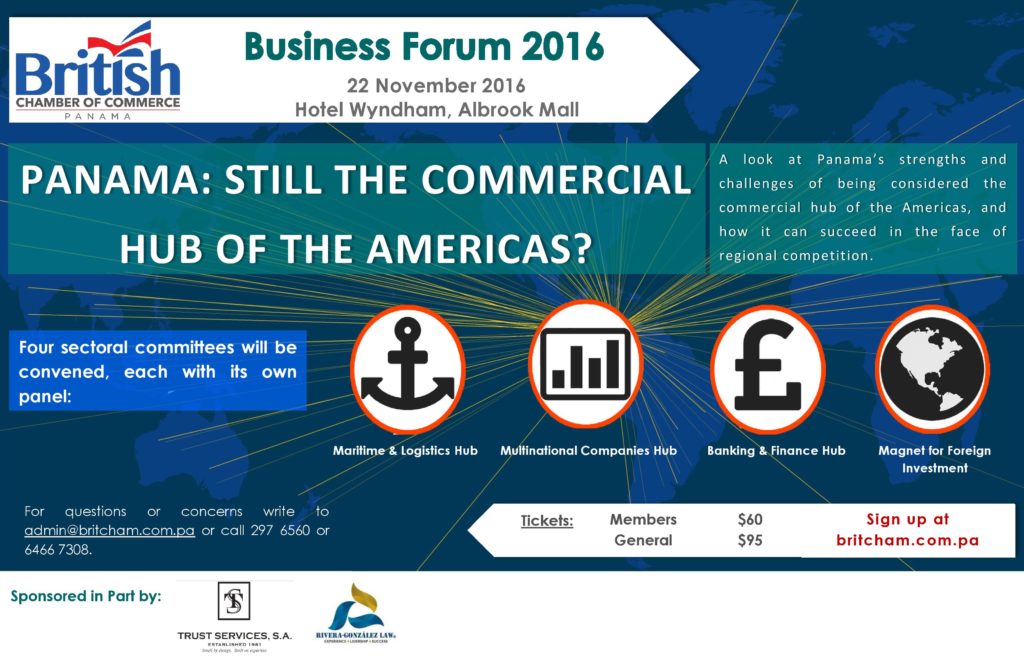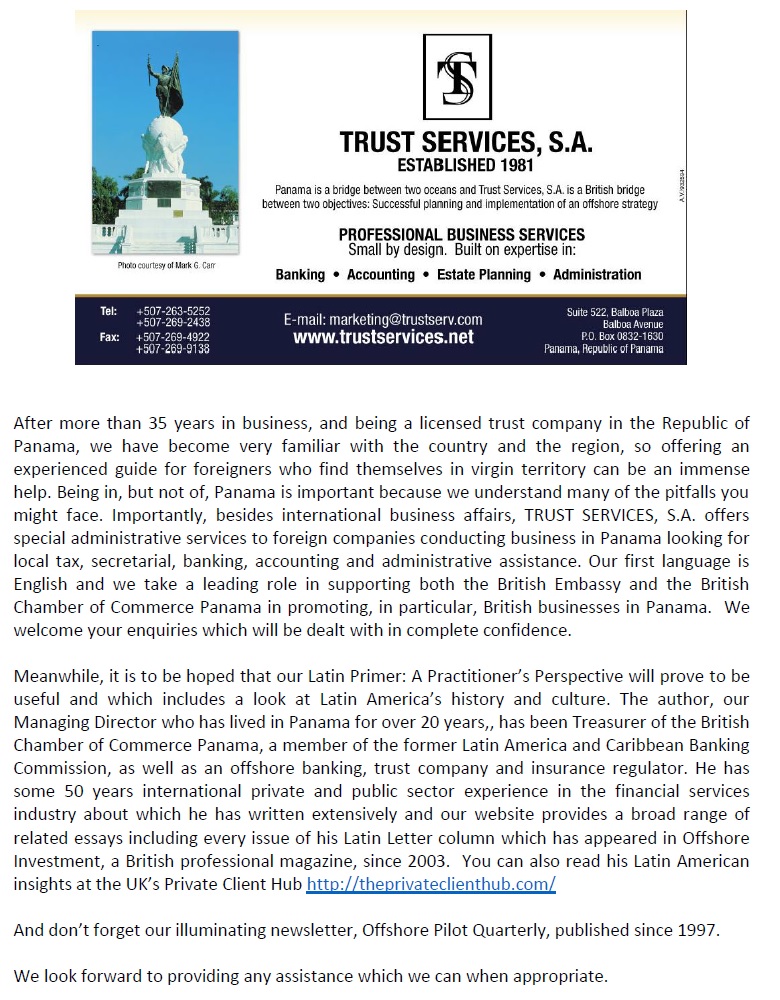
The British Chamber in Panama is back with its annual Business Forum, titled “Panama: Still the Commercial Hub of the Americas?”. The focus this year is on Panama’s “hub-ness”, or its status as a business centre for the Americas.
Throughout the half-day conference, a series of panellists in four separate committees will try to evaluate whether Panama, after a decade of sustained growth, is still a regional commercial hub in the face of growing regional competition, and difficulty integrating into a strictly regulated international financial system. Our combination of governmental and private-sector panellist will be tasked with evaluating Panama’s achievements in establishing itself, on a public and private level, as a hub for regional commercial activity. Additionally, they will evaluate the challenges the country faces in this respect, the future opportunities, and how to face regional competition in various sectors.
Sectoral Committees
Below are the sectoral committees that we will be dividing the Forum into, each with its own description.
It is undeniable that the Panama Canal has made the country a centre for maritime operations. With the establishment of the second-larges free economic zone in the world, and world-class ports on both coasts, Panama has long been considered a regional logistics hub. So much so that the second and third busiest ports in Latin America are located in Panama (Balboa and Manzanillo). Additionally, because of its unique geographic location, many large multinational companies use Panama to move their products regionally. Add to that an expanded Canal that is seeing increased traffic, and you have the ingredients of a world-class shipping and logistical hub.
However, over the past few years the global shipping market has taken a nose-dive, and in 2016 movement of containers in ports has also fallen globally. This is why the Panamanian Government and the Panama Canal Authority have taken the decision to develop more logistical zones that offer value-added services. The Panama Canal Authority also plans to develop a new port on its banks, a new LNG terminal, and a new logistical park.
Indeed Panama is taking steps to improve its maritime and logistics sector, but it also faces stiff competitions from other countries in the region, such as Colombia and Nicaragua, who are pumping large amounts of capital to update their port and logistical infrastructure. To stay ahead of its competition, the Government has to act fast in updating the Panamanian infrastructure and bring together public policy on the sector in the National Logistics Plan.
Some of the questions that will be posited to the panel will be:
- What have been some of Panama’s achievements in the maritime & logistics sector?
- What have been some of the regional trends for the sector?
- Will there be any governmental policy towards preventing the over-saturation of logistical and maritime activity in one area of the country?
- How can other parts of the country be part of the logistical and maritime activity?
- How will Panama stay ahead of regional competition?
- What are some of the deficiencies/challenges the sector faces?
Over the past nine years Panama has become home to almost 130 multinational companies that have established their regional headquarters in the country. This is just in a special government-sponsored regime that gives multinationals several fiscal, labour and migratory benefits; there are many other multinational companies that have established themselves in Panama out of this framework.
The reason many multinational companies set up their regional operations in Panama is because of its excellent logistical connectivity, including land, sea and air routes, and the presence of two major economic zones, the Colon Free Zone and the Panama Pacific Economic Area, which offer many benefits to companies.
However, despite the many fiscal benefits that multinational companies receive in Panama, there are still several challenges that multinational companies face in Panama. One of the biggest hurdles that they face is lack of qualified labour. Many times companies have to bring middle and upper management, and some in special cases technical expertise, from abroad to satisfy their demand for labour. Additionally, multinational companies often find a lack of English-speaking employees.
To alleviate the labour issue, the Government is developing a Technical Institute that will train thousands of students in technical, customer service, and language skills to be more competitive in the market. Another challenge within the labour field is government restrictions on how many foreigners can work in their companies. This could lead to issues as the company may not find enough local qualified labour to fill its demand, but because of restrictions it can’t bring more from abroad.
Finally, other top challenges faced by multinationals is governmental bureaucracy, corruption, lack of transparency and inefficiencies. There still isn’t any clear separation of powers between the executive and judiciary, and there are still issues with protecting investors and enforcing contracts. Panama’s slow justice system also hinders any conflicts that arise to be resolved.
Some of the questions that will be put forth to our panel are:
- Compared to other countries in the region, what benefits does Panama provide multinational companies?
- Will there be any relaxing of rules to allow multinationals to hire more foreigners than the quota allows?
- Will the foreign labourers law in the Panama Pacifico Free Economic Area change after the first batch of students graduate from the technical schools?
- What measures is the Government taking to address the judicial issues, particularly with international companies?
Aside from being known for its Canal, Panama is also known as an international financial centre. Its dollarisation of the economy provides a great environment to transfer funds from the region to international banks. Unfortunately, Panama has also gained a reputation as a secretive tax haven among many nations, despite it being the contrary case in a majority of instances. This sort of perception has hindered Panama’s advance into a financial centre at the level of New York and London.
Despite this, Panama has made many advances in bilateral exchange of information agreements, tax structures, and financial transparency. All these reforms come under the umbrella of broader OECD regulations that Panama was asked to comply with. On the private sector front, banks are now broadening their compliance and due-diligence activities.
Panama has also been a place for many international banks to set up offices. Most notably, HSBC had their regional offices in Panama, and at one point were the largest bank in Central America. Other international banks include BanColombia, Austrobank and Scotiabank. What the country hopes is that with the advances made in keeping up with regulations that more and more international banks, particularly European and American, will do business with Panama, and establish regional offices here.
Some of the questions that will be put forth to the panel are:
- How have Panama’s financial reforms been perceived by the international community, particularly private sector financial entities?
- Does the local finance sector have any inclination to move away solely from banking and offshore activities, and move into other financial products/services that are often seen in other international markets?
- Has the “Panama Papers” story had any real impact on the finance sector?
- Where does the Panamanian Government want to take the local financial sector in the near future?
Over the past decade Panama has experienced unprecedented economic growth. A large part of this has been thanks to billions in foreign investment in various sectors from real estate and infrastructure, to retail and tourism. Historically, the country has attracted merchants from all around the world, and now is no exception. Day by day there are companies and individuals bringing investments to Panama.
Multinational companies establishing regional operations do make up most of the investment, but several small businesses are also comprised of foreign capital. Some of the top reasons investors find Panama attractive are its political and economic stability, and its great connectivity within the region. The Government of Panama has taken notice of this influx of foreign capital and designed many different incentives for companies to continue investing in the country.
Panama is leading Central America in foreign investment, with more than half of the region’s FDI coming here. However, other emerging economies in the region, such as Guatemala, Nicaragua, Colombia and Peru are also attracting lots of international companies.
Some of the questions that will be put forth to the panel are:
- How has the rate of foreign investment changed in Panama?
- What initially prompted the Government to make FDI attraction a public policy, and should the policy be modified to fit with future objectives?
- What sectors have seen the most growth in FDI?
- Is there a risk for Panama losing FDI to regional competition?
Thank you to our Sponsors!
Thank you to our Gold Sponsor- Rivera-Gonzalez Law

Thank you to our Committee Sponsor- Quijano & Asociados
Thank you to our Sponsor- British Embassy in Panama



